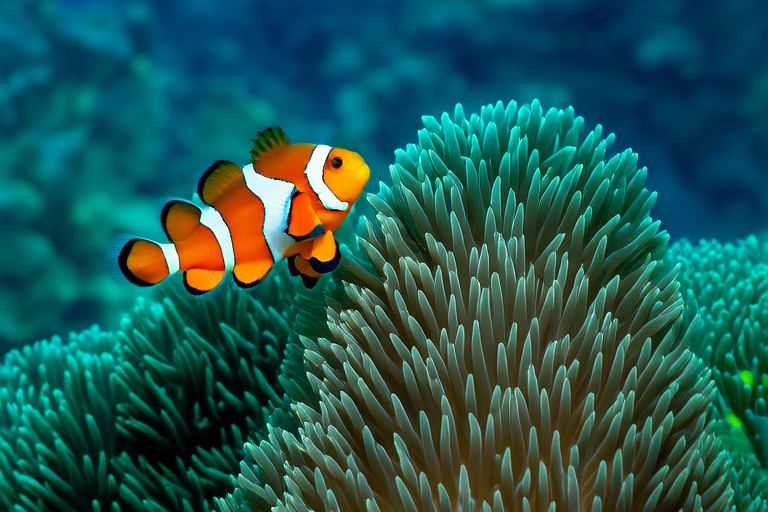Clownfish: Secrets and Survival Strategies
Clownfish, with their vibrant colors and endearing behavior, have captured the hearts of many. These small, yet fascinating creatures belong to the genus Amphiprion, and they live in a complex world that is both beautiful and perilous. In this article, we will explore the behaviors and secret habits of clownfish in their natural habitat and captivity, delving into their social structures, mating rituals, defensive mechanisms, and interactions within the sea anemone. We’ll also discuss how environmental factors influence their daily routines and long-term survival strategies.
Social Structures and Mating Rituals
In the wild, clownfish live in tight-knit groups within sea anemones. Typically, these groups consist of one breeding pair and several non-breeding individuals. The breeding pair is responsible for producing offspring, while the non-breeding individuals help protect and care for the group’s eggs and young. This hierarchical structure ensures that only the most dominant pair reproduces, maximizing genetic fitness.
Mating rituals among clownfish are elaborate and fascinating. When it’s time to mate, the female initiates the process by nudging the male with her snout. This triggers the male to release sperm, which is then fertilized by the eggs laid by the female. Afterward, both parents take turns guarding the eggs until they hatch, ensuring the survival of their offspring.
Interestingly, clownfish can change their sex if necessary. If the dominant female dies, the next most dominant male in the group will transform into a female, allowing the group to continue breeding without interruption.
Defensive Mechanisms and Interactions Within the Sea Anemone
One of the most remarkable aspects of clownfish is their symbiotic relationship with sea anemones. The sea anemone provides protection for the clownfish by stinging any potential predators that come too close. In return, the clownfish brings nutrients to the anemone through its waste products and by driving away polyp-eating fish.
Despite this seemingly perfect partnership, clownfish must be cautious around their host. They develop a layer of mucus on their skin that protects them from the anemone’s stinging cells, known as nematocysts. This adaptation allows them to safely navigate within the anemone without being harmed.
When threatened, clownfish exhibit various defensive behaviors. They may dart quickly between the tentacles of the anemone or swim rapidly around their host to confuse potential predators. Additionally, they often display a bright color pattern that serves as a warning signal to larger fish, indicating that they are unpalatable due to their toxic mucus.
Environmental Factors and Daily Routines
The daily routines of clownfish are heavily influenced by environmental factors such as temperature, light, and water quality. Clownfish are diurnal, meaning they are most active during the day when there is plenty of light for them to see and hunt. As the sun rises, they begin to emerge from their anemone homes to search for food, primarily consisting of algae, zooplankton, and small crustaceans.
As evening approaches, clownfish retreat back into the safety of their anemone. This routine helps them conserve energy and avoid predation during the darker hours when their visibility decreases. However, environmental changes can disrupt this cycle. For example, increased pollution or rising temperatures can alter feeding patterns and resting times, potentially affecting their overall health and survival.
Long-Term Survival Strategies
To ensure long-term survival, clownfish employ several strategies. One key strategy is their ability to adapt to changing environments. As coral reefs face threats from climate change, overfishing, and pollution, clownfish have shown resilience by adjusting their behavior and physiology. For instance, they can tolerate slight increases in water temperature and acidity, allowing them to survive in less-than-ideal conditions.
Another important aspect of their survival is their reproductive strategy. By producing numerous offspring and maintaining a strict hierarchy within their groups, clownfish increase the chances of at least some of their young surviving to adulthood. Additionally, their ability to change sex allows them to maintain stable breeding pairs even when faced with unexpected losses.
Clownfish in Captivity
Clownfish have become popular pets for aquarium enthusiasts due to their striking appearance and relatively easy care requirements. However, keeping clownfish in captivity presents unique challenges. Aquarium owners must replicate the conditions found in their natural habitats, including providing a suitable host anemone or alternative hiding spots, maintaining proper water quality, and offering a varied diet.
One common issue faced by captive clownfish is stress caused by improper tank setup or handling. Stress can lead to weakened immune systems, making the fish more susceptible to diseases. Therefore, it’s crucial for aquarium owners to provide a well-balanced environment that mimics the natural habitat as closely as possible.
Moreover, breeding clownfish in captivity requires careful planning and attention to detail. It involves creating optimal breeding conditions, monitoring egg development, and ensuring proper care for newly hatched fry. Many aquarium hobbyists find this rewarding but challenging endeavor fascinating.
Conclusion
Clownfish are truly remarkable creatures with complex social structures, intricate mating rituals, and effective defensive mechanisms. Their symbiotic relationship with sea anemones and ability to adapt to changing environments make them resilient survivors. Whether in their natural habitat or in captivity, clownfish continue to captivate marine biologists and aquarium enthusiasts alike with their unique behaviors and survival strategies.
